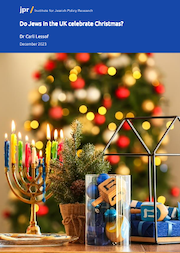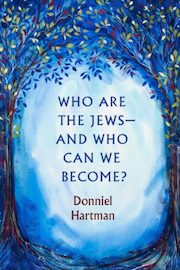
Most of the Jewish world’s attention is still focused – appropriately I would say – on what’s happening in Israel. But it feels right to start reporting and commenting on interfaith inclusion news again. Especially since December is always a big month for interfaith families.
December Holidays
 The UK Institute for Jewish Policy Research issued a new study that found that 28% of Jews in the UK have a Christmas tree at least some years. For interfaith couples, it’s 45% every year, compared to 36% who light Hanukkah candles. I appreciated that the JPR referred to Christmas trees as a “cultural manifestation.”
The UK Institute for Jewish Policy Research issued a new study that found that 28% of Jews in the UK have a Christmas tree at least some years. For interfaith couples, it’s 45% every year, compared to 36% who light Hanukkah candles. I appreciated that the JPR referred to Christmas trees as a “cultural manifestation.”
Most important, the JPR, which is a pretty traditional organization, did not criticize or bemoan the presence of Christmas trees, but instead calmly concluded that the findings “capture both the tenacity of Jewishness today and the realities of Jewish life in the modern multicultural age… Maintaining a Jewish identity in a non-Jewish society has long been a challenge; the ways in which we adopt non-Jewish customs and practices says a great deal about who we are and how we manage those dynamics.” (The Jewish News article on the report had a catchy title – “Oy to the World” – and refers to “ChristmasTreeGate” – but ultimately quotes the same conclusion.)
I read a few stories in Jewish and secular media about how interfaith families were celebrating the December holidays, but didn’t really notice anything new. The Reform movement’s website had some nice and very accepting advice in Five Ways to Approach Family Conversations Around Hanukkah and Christmas.
There was one story I didn’t care for, “I packed away Christmas 35 years ago, but I still bring holiday joy to others.” Janet Silver Ghent grew up in a Jewish family that celebrated Christmas, then married and divorced a man who was not Jewish, then married a Jewish man who had been in an interfaith marriage; at that point she gave up Christmas because she “reclaimed [her] Jewish identity after decades of assimilation.” She told a step-daughter, who asked why they couldn’t have a little tree, “a little tree is like a little pregnant.”
Ghent’s story stood out to me for a tone that is critical of Jewish families that celebrate Christmas, something I did not see much of elsewhere this December. Assimilation means losing Jewish identity and practice; it seems that more and more people in the Jewish world understand that having a Christmas tree does not mean that an interfaith family has assimilated.
Attitudes about Interfaith Marriage
The Shalom Hartman Institute and its co-president Donniel Hartman, an Orthodox rabbi, are deservedly among the most highly-regarded Jewish educational institutions and leaders in the world. When someone of Rabbi Hartman’s stature speaks about engaging interfaith families positively, it’s amazing, a cause for celebration.
 In his new book, Who Are The Jews – And Who Can We Become, Hartman refers to “non-assimilationist exogamy;” says “most North American Jews who marry non-Jews do not see selves as rejecting Jewishness;” says interfaith marriage “can no longer be a boundary that defines Jewishness – it is now the norm of Jewish life;” talks about expanding “the parameters of Jewish identity” and “the inclusion of intermarried Jews and their spouses who chose to join us;” and recommends, “rather than digging our heels into a self-defeating discourse of denial, we marshal our collective creativity to ensure a vital next chapter in the Jewish people’s story.” This was all music to my ears.
In his new book, Who Are The Jews – And Who Can We Become, Hartman refers to “non-assimilationist exogamy;” says “most North American Jews who marry non-Jews do not see selves as rejecting Jewishness;” says interfaith marriage “can no longer be a boundary that defines Jewishness – it is now the norm of Jewish life;” talks about expanding “the parameters of Jewish identity” and “the inclusion of intermarried Jews and their spouses who chose to join us;” and recommends, “rather than digging our heels into a self-defeating discourse of denial, we marshal our collective creativity to ensure a vital next chapter in the Jewish people’s story.” This was all music to my ears.
I was equally amazed when the institute’s US-based co-president, Yehuda Kurtzer, another top Jewish public intellectual, in an opinion about the reshaping of the American Zionist left after October 7, said, “[T]he big tent should be inclusive of anyone seeking to belong. One fascinating outcome of this could mean that we stop the decadeslong obsession with intermarriage as the marker of Jewish peoplehood. After Oct. 7, identification with the Jewish people at a time of suffering is a much healthier, and maybe more accurate, indicator of belonging.”
Speaking of top intellectual leaders, I was very saddened by the death of Rabbi David Ellenson, the much beloved past president of Hebrew Union College. As explained in my remembrance, he had the most remarkable generosity of spirit of anyone I ever met. Although I publicly criticized his decision to maintain HUC’s policy not to admit rabbinic students in interfaith relationships, he became a supporter and a friend, publicly endorsing InterfaithFamily’s work several times, speaking at the afternoon of learning when I retired from InterfaithFamily, and providing the cover endorsement for my book. He never said this to me, but I can only imagine that he felt our policy differences were disputes for the sake of heaven.
Research
The Cohen Center at Brandeis released the 2022 San Diego Jewish Community Study. In San Diego, 49% of married Jewish individuals are intermarried, and 67% of couples that include a Jewish person are intermarried; in intermarried households, 55% of children are considered by their parents to be Jewish, and another 20% are considered to be Jewish and another religion. During 2024 I hope to complete my analysis of the Cohen Center’s recent local community studies.
I am excited about the prospects of a new study, funded by the Crown Family, Harold Grinspoon and Jim Joseph foundations. The study by Rosov Consulting and led by Alex Pomson will explore “the interests, needs, hopes, and challenges of a wide diversity of Jewish families, including those with more than one religious or cultural tradition…” They will examine which elements of the parents’ heritages they wish to continue, which they have chosen not to, and why.
The first part of the study is a just-released review of research which clearly notes that welcoming Jewish attitudes and institutions make a difference. I appreciated the review’s statement that the last decade’s research “dispels the still-common tropes in communal discourse about the ‘dangers’ [interfaith families] pose to Jewish continuity.” I appreciated the recognition that structural factors, including institutional policies and ideologies, impact on couples’ decision. For interfaith families, that means experiencing pressure to convert, encountering attitudes and policies that privilege matrilineal descent, and hearing interfaith marriage characterized as a problem. I appreciated the review’s noting that for LGBTQ+ couples who are also interfaith, “many of the Christian partners were more favorably inclined toward Judaism because they viewed the Jewish community as more welcoming of LGBTQ+ people.”
I liked what the review said about terminology:
[W]e use the term “interfaith” to refer to all couples and their families in which one partner is Jewish (in some way) and the other is from a different religious, cultural or ethnic background, including those in which one partner has converted to Judaism, those in which each partner adheres to a different faith tradition, and those who do not consider themselves to be religious. All such families face similar challenges in negotiating which elements of the parents’ childhood heritage to perpetuate or discard.
Finally, coming full circle back to December, the review also notes the negative influence of Jews choosing to “code” Christmas traditions as “religious” and not “cultural,” and “therefore incompatible with a Jewish home, even though … arguably devoid of strictly religious meaning for many who engage in them.”
I find all of this very promising, and look forward to further reports as the study takes shape.
* * * * * *
At this difficult time, I hope your December holidays were as good as they could be, and I send sincere wishes for a good and better new year.

Leave a Reply